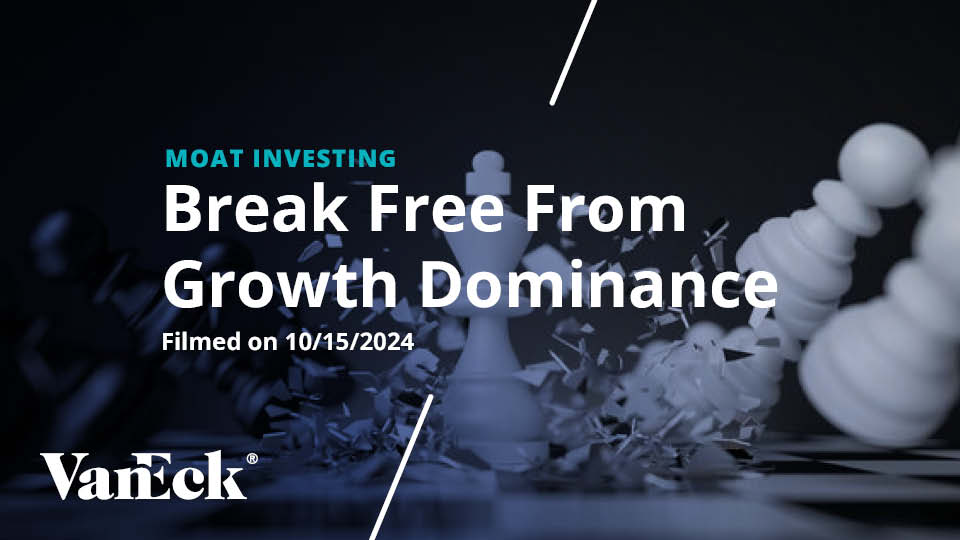Growth vs. Value Investing: Key Differences and Strategies
23 October 2024
Growth vs. Value Investing: Key Differences & Investing Strategies
Among the various investment approaches available, growth and value investing stand out due to their distinct methodologies and the different types of opportunities they target. Understanding these investment styles is essential for investors to align their investment decisions with their financial goals and risk tolerance. This guide aims to demystify the differences between growth and value investing and to help you determine which strategy might be better suited to your investment objectives.
The Basics Behind Growth & Value Investing
There are fundamental differences that distinguish value stocks from growth stocks. In the following sections, we explore the differences between the two styles to help investors better understand how both might fit into their broader portfolio allocation.
What is Growth Investing?
Growth investing focuses on acquiring stocks of companies that exhibit signs of above-average growth, even if the share price appears expensive in terms of metrics like price-to-earnings ratios. Investors who adopt this strategy anticipate earnings growth that will eventually justify the higher price. Notable examples of growth stocks include technology companies like Amazon and Google, which have historically provided substantial returns due to their disruptive innovations and market dominance.
What is Value Investing?
Value investing involves picking stocks that appear underpriced relative to their intrinsic value, which is determined through fundamental analysis. Value investors seek stocks that are undervalued by the market and thus expected to provide superior returns when the market corrects the mispricing. Value stocks are often mature and stable companies that pay regular dividends, making them attractive to lower-risk value investors. Classic examples of value stocks include Berkshire Hathaway, which is led by Warren Buffett. It’s often cited as a quintessential value stock because of its diversified holdings in undervalued companies and its conservative management style.
Key Differences Between Growth and Value Investing
Growth and value investing differ fundamentally in their approach to selection and assessment of stocks. Growth investors are typically less concerned with the current price of the stock relative to its fundamentals and more with the potential for significant growth in revenues and earnings. In contrast, value investors focus on obtaining stocks at a price that implies a discount to their true worth.
Performance in Market Conditions
The performance of growth and value investing can vary significantly under different market conditions. Growth stocks tend to perform well during economic expansions when investors are willing to pay premiums for higher earnings growth. Conversely, value stocks often outperform during a market downturn, as they are perceived as safer investments due to their undervaluation.
Historical Performance and Cyclicality
Historically, the success of growth and value investing has been cyclical. There have been periods when growth stocks have significantly outperformed value stocks and vice versa. This cyclical nature suggests that economic, geopolitical, and sector-specific factors can impact the performance of each strategy differently.
The table below provides a general overview of how value and growth stocks differ across several key dimensions:
| Characteristic | Value Stocks | Growth Stocks |
| Price Metrics | Typically have lower price-to-earnings ratios. | Usually have higher price-to-earnings ratios. |
| Market Perception | Seen as underpriced compared to their intrinsic value. | Viewed as more richly priced based on current earnings. |
| Dividends | Often pay higher dividends. | May pay little to no dividends, reinvesting profits into growth. |
| Risk | Perceived as lower risk due to undervaluation, and tendency to be in more mature business stages with more stable earnings. | Considered higher risk due to high valuations and expectations. |
| Investment Appeal | Attractive during economic downturns or market corrections. | Favored in bullish or rapidly growing economic environments. |
| Company Characteristics | Mature companies with stable earnings. | Young or rapidly expanding companies with high growth rates. |
| Earnings Growth | Slow to moderate earnings growth. | Rapid earnings growth. |
Factors to Consider When Choosing Between Value or Growth Stocks
Investors should consider their risk profile, investment goals, and the current market outlook when choosing between growth and value stocks. For instance, those with a higher risk tolerance may prefer the potentially higher returns of growth stocks, while more conservative investors may opt for the perceived safety of value stocks.
To receive more Moat Investing insights, sign up to our newsletter.
IMPORTANT INFORMATION
This is a marketing communication. Please refer to the prospectus of the UCITS and to the KID before making any final investment decisions. This information originates from VanEck (Europe) GmbH, which has been appointed as distributor of VanEck products in Europe by the Management Company VanEck Asset Management B.V., incorporated under Dutch law and registered with the Dutch Authority for the Financial Markets (AFM). VanEck (Europe) GmbH with registered address at Kreuznacher Str. 30, 60486 Frankfurt, Germany, is a financial services provider regulated by the Federal Financial Supervisory Authority in Germany (BaFin).
The information is intended only to provide general and preliminary information to investors and shall not be construed as investment, legal or tax advice VanEck (Europe) GmbH and its associated and affiliated companies (together “VanEck”) assume no liability with regards to any investment, divestment or retention decision taken by the investor on the basis of this information. The views and opinions expressed are those of the author(s) but not necessarily those of VanEck. Opinions are current as of the publication date and are subject to change with market conditions. Certain statements contained herein may constitute projections, forecasts and other forward-looking statements, which do not reflect actual results. Information provided by third party sources is believed to be reliable and have not been independently verified for accuracy or completeness and cannot be guaranteed. Brokerage or transaction fees may apply.
All performance information is based on historical data and does not predict future returns. Investing is subject to risk, including the possible loss of principal.
No part of this material may be reproduced in any form, or referred to in any other publication, without express written permission of VanEck.
© VanEck (Europe) GmbH
Important Disclosure
This is a marketing communication. Please refer to the prospectus of the UCITS and to the KID before making any final investment decisions.
This information originates from VanEck (Europe) GmbH, which has been appointed as distributor of VanEck products in Europe by the Management Company VanEck Asset Management B.V., incorporated under Dutch law and registered with the Dutch Authority for the Financial Markets (AFM). VanEck (Europe) GmbH with registered address at Kreuznacher Str. 30, 60486 Frankfurt, Germany, is a financial services provider regulated by the Federal Financial Supervisory Authority in Germany (BaFin).
The information is intended only to provide general and preliminary information to investors and shall not be construed as investment, legal or tax advice VanEck (Europe) GmbH, VanEck Switzerland AG, VanEck Securities UK Limited and their associated and affiliated companies (together “VanEck”) assume no liability with regards to any investment, divestment or retention decision taken by the investor on the basis of this information. The views and opinions expressed are those of the author(s) but not necessarily those of VanEck. Opinions are current as of the publication date and are subject to change with market conditions. Certain statements contained herein may constitute projections, forecasts and other forward-looking statements, which do not reflect actual results. Information provided by third party sources is believed to be reliable and have not been independently verified for accuracy or completeness and cannot be guaranteed. Brokerage or transaction fees may apply.
VanEck Asset Management B.V., the management company of VanEck Morningstar US Sustainable Wide Moat UCITS ETF (the "ETF"), a sub-fund of VanEck UCITS ETFs plc, is a UCITS management company under Dutch law registered with the Dutch Authority for the Financial Markets (AFM). The ETF is registered with the Central Bank of Ireland, passively managed and tracks an equity index. Investing in the ETF should be interpreted as acquiring shares of the ETF and not the underlying assets. Investors must read the sales prospectus and key investor information before investing in a fund. These are available in English and the KIIDs/KIDs in certain other languages as applicable and can be obtained free of charge at www.vaneck.com, from the Management Company or from the following local information agents:
UK - Facilities Agent: Computershare Investor Services PLC
Austria - Facility Agent: Erste Bank der oesterreichischen Sparkassen AG
Germany - Facility Agent: VanEck (Europe) GmbH
Spain - Facility Agent: VanEck (Europe) GmbH
Sweden - Paying Agent: Skandinaviska Enskilda Banken AB (publ)
France - Facility Agent: VanEck (Europe) GmbH
Portugal - Paying Agent: BEST – Banco Eletrónico de Serviço Total, S.A.
Luxembourg - Facility Agent: VanEck (Europe) GmbH
Morningstar® US Sustainability Moat Focus Index is a trade mark of Morningstar Inc. and has been licensed for use for certain purposes by VanEck. VanEck Morningstar US Sustainable Wide Moat UCITS ETF is not sponsored, endorsed, sold or promoted by Morningstar and Morningstar makes no representation regarding the advisability in VanEck Morningstar US Sustainable Wide Moat UCITS ETF.
Effective December 17, 2021 the Morningstar® Wide Moat Focus IndexTM has been replaced with the Morningstar® US Sustainability Moat Focus Index.
Effective June 20, 2016, Morningstar implemented several changes to the Morningstar Wide Moat Focus Index construction rules. Among other changes, the index increased its constituent count from 20 stocks to at least 40 stocks and modified its rebalance and reconstitution methodology. These changes may result in more diversified exposure, lower turnover and longer holding periods for index constituents than under the rules in effect prior to this date.
It is not possible to invest directly in an index.
All performance information is based on historical data and does not predict future returns. Investing is subject to risk, including the possible loss of principal.
No part of this material may be reproduced in any form, or referred to in any other publication, without express written permission of VanEck.
© VanEck (Europe) GmbH / VanEck Asset Management B.V.
Sign-up for our ETF newsletter
Related Insights
Related Insights
24 October 2024
14 November 2024
24 October 2024
14 October 2024
14 October 2024






